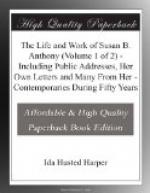CHAPTER XX.
FIFTIETH BIRTHDAY—END OF EQUAL RIGHTS SOCIETY.
1870.
Conventions and conventions for fifty years, without a break, planned and managed by one woman—was there ever a similar record? The year 1870 opened with the Second National Woman Suffrage Convention, in Lincoln Hall, Washington, D. C., January 19. It had been advertised for two days, but the interest was so great that it was continued through the third day and evening. Mrs. Stanton was in the chair and the papers united in praising the beauty, dignity and elegant attire of the women on the platform. A long table at the Arlington Hotel was reserved for them, and Miss Anthony relates that as they were all going into the dining-room one day, Jessie Benton Fremont beckoned to her and when she went over to the table where the general and she were sitting, she said in her bright, pretty way: “Now tell me, did you hunt the country over and pick out a score of the most beautiful women you could find to melt the hearts of our congressmen?”
Letters of warm approval were read from John Stuart Mill and Helen Taylor, of England; Professor Homer B. Sprague, of Cornell University; Bishop Simpson, of the Methodist church; Senator Matthew H. Carpenter, and many other distinguished persons. A number of senators and representatives addressed the meetings, as did also Hon. A.G. Riddle, of the District of Columbia, Rev. Samuel J. May, Charlotte B. Wilbour, Isabella Beecher Hooker, and the usual corps of well-known suffrage speakers. Jennie Collins, the Lowell factory girl, electrified the audience by discussing the great question from the standpoint of the workingwomen. All the New York dailies sent women reporters, a comparatively new feature at conventions.
A hearing was arranged before the joint committees for the District of Columbia, and a number of the ladies made short addresses. Mrs. Stanton based her remarks on the unanswerable argument of Francis Minor at the St. Louis convention a few months before, the first assertion of woman’s right to vote under the Fourteenth Amendment. Miss Anthony said:
We are here for the express purpose of urging you to present in your respective bodies, a bill to strike the word “male” from the District of Columbia Suffrage Act and thereby enfranchise the women of the District. We ask that the experiment of woman suffrage shall be made here, under the eye of Congress, as was that of negro suffrage. Indeed, the District has ever been the experimental ground of each step toward freedom. The auction-block was here first banished, slavery here first abolished, the freedmen here first enfranchised; and we now ask that women here shall be first admitted to the ballot. There was great fear and trepidation all over the country as to the results of negro suffrage, and you deemed it right and safe to inaugurate the experiment here; and you all remember




